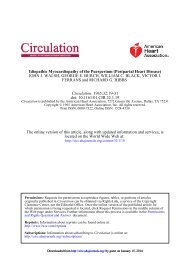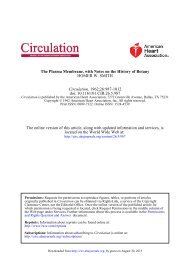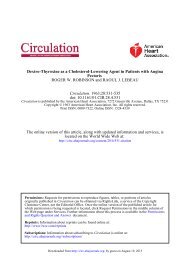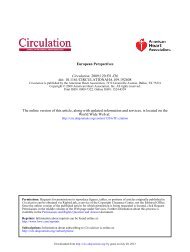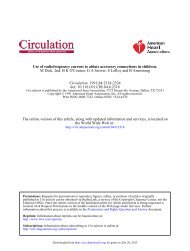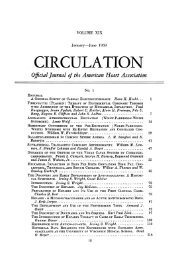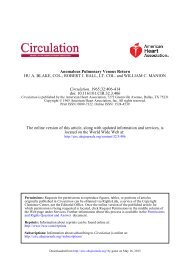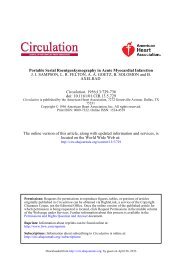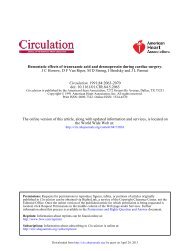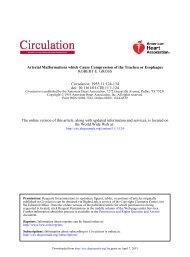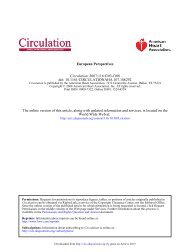Catheter Ablation of Mahaim Fibers With Nodal ... - Circulation
Catheter Ablation of Mahaim Fibers With Nodal ... - Circulation
Catheter Ablation of Mahaim Fibers With Nodal ... - Circulation
Create successful ePaper yourself
Turn your PDF publications into a flip-book with our unique Google optimized e-Paper software.
<strong>Catheter</strong> ablation <strong>of</strong> <strong>Mahaim</strong> fibers with preservation <strong>of</strong> atrioventricular nodal<br />
conduction.<br />
M Haissaguerre, J F Warin, P Le Metayer, L Maraud, L De Roy, P Montserrat and J P<br />
Massiere<br />
<strong>Circulation</strong>. 1990;82:418-427<br />
doi: 10.1161/01.CIR.82.2.418<br />
<strong>Circulation</strong> is published by the American Heart Association, 7272 Greenville Avenue, Dallas, TX 75231<br />
Copyright © 1990 American Heart Association, Inc. All rights reserved.<br />
Print ISSN: 0009-7322. Online ISSN: 1524-4539<br />
The online version <strong>of</strong> this article, along with updated information and services, is located on<br />
the World Wide Web at:<br />
http://circ.ahajournals.org/content/82/2/418<br />
published Permissions: Requests for permissions to reproduce figures, tables, or portions <strong>of</strong> articles originally<br />
in <strong>Circulation</strong> can be obtained via RightsLink, a service <strong>of</strong> the Copyright Clearance Center, not the<br />
Editorial Office. Once the online version <strong>of</strong> the published article for which permission is being requested is<br />
located, click Request Permissions in the middle column <strong>of</strong> the Web page under Services. Further<br />
information about this process is available in the Permissions and Rights Question and Answer document.<br />
by guest on August 25, 2013<br />
Reprints: Information about reprints can be found online at:<br />
http://www.lww.com/reprints<br />
Subscriptions: Information about subscribing to <strong>Circulation</strong> is online at:<br />
http://circ.ahajournals.org//subscriptions/<br />
Downloaded from http://circ.ahajournals.org/
418<br />
<strong>Catheter</strong> <strong>Ablation</strong> <strong>of</strong> <strong>Mahaim</strong> <strong>Fibers</strong> <strong>With</strong><br />
Preservation <strong>of</strong> Atrioventricular<br />
<strong>Nodal</strong> Conduction<br />
Michel Haissaguerre, MD, Jean-Frangois Warin, MD, Philippe Le Metayer, MD,<br />
Luc Maraud, MD, Luc De Roy, MD, Paul Montserrat, MD, and Jean-Paul Massiere, MD<br />
Three patients with refractory preexcited tachycardia implicating <strong>Mahaim</strong> fibers underwent<br />
attempted catheter ablation <strong>of</strong> the accessory pathway. In the absence <strong>of</strong> demonstrable<br />
retrograde conduction in <strong>Mahaim</strong> fibers, we located the accessory pathway ventricular<br />
insertion site using the criteria <strong>of</strong> concordance between paced and spontaneous QRS morphologies<br />
during pace-mapping and earliest onset <strong>of</strong> local electrogram relative to surface preexcited<br />
QRS. At this site, a QS-like pattern <strong>of</strong> unfiltered unipolar electrograms with steep downstroke<br />
was recorded. The optimal site appeared radiologically at the right ventricular anterior wall or<br />
the adjacent septum, 2-4 cm from the tricuspid anulus. Three to six 160-J shocks were<br />
delivered at this site using an anterior chest wall plate as anode. After fulguration, conduction<br />
through the <strong>Mahaim</strong> tract was absent. A right bundle branch block persisted in two patients.<br />
All patients remained free <strong>of</strong> preexcited tachycardia during 12-16 months <strong>of</strong> follow-up.<br />
Postablation electrophysiological assessment showed no preexcitation in any patient. No<br />
reciprocating tachycardia was inducible, even during isoproterenol infusion. Atrioventricular<br />
nodal conduction parameters were unchanged from baseline study. <strong>Catheter</strong> ablation <strong>of</strong><br />
<strong>Mahaim</strong> fibers is an effective alternative method for the treatment <strong>of</strong> tachycardias that include<br />
the accessory pathway in the circuit. (<strong>Circulation</strong> 1990;82:418-427)<br />
P atients with <strong>Mahaim</strong> fibers are prone to paroxysmal<br />
reciprocating tachycardias.1-23 These<br />
anomalous conduction pathways can either<br />
participate in the reentrant circuit or serve a bystander<br />
role.6,8,10,12,14-16,21 Recently, specific surgical<br />
interruption <strong>of</strong> <strong>Mahaim</strong> fibers has been reported by<br />
several authors24-27 for disabling and drug-refractory<br />
tachycardias. Because <strong>of</strong> their presumed intimate<br />
relation with the atrioventricular node, these fibers<br />
have been thought to be unapproachable by ablative<br />
techniques due to the risk <strong>of</strong> complete atrioventricular<br />
block. However, His bundle ablation has been<br />
performed in some patients12,28-30; although anterograde<br />
conduction continued over the accessory pathway<br />
in certain patients,12,28,29 a permanent pacemaker<br />
was <strong>of</strong>ten implanted. In this report, we<br />
describe three patients whose <strong>Mahaim</strong> fibers were<br />
successfully ablated by endocardial DC shocks<br />
applied at the ventricular insertion <strong>of</strong> the pathway.<br />
From the Service de Cardiologie et Medecine Interne (M.H.,<br />
J.-F.W., P.L.M., L.M., P.M., J.-P.M.), Hopital Saint-Andre, Bordeaux,<br />
France, and Cliniques Universitaires (L.D.R.), UCL,<br />
Mont-Godinne, Belgium.<br />
Address for correspondence: Michel Haissaguerre, MD, Hopital<br />
Saint-Andre, 1, rue Jean Burguet, 33075 Bordeaux, France.<br />
Received May 16, 1989; revision accepted April 3, 1990.<br />
Moreover, this study provides some anatomical and<br />
electrophysiological insights into <strong>Mahaim</strong> fibers.<br />
Methods<br />
Patient Characteristics<br />
Three patients (52, 25, and 31 years old) were<br />
referred for treatment <strong>of</strong> disabling paroxysmal wide<br />
QRS tachycardias with left bundle branch block<br />
morphology and superior axis (Figure 1). Patient 1<br />
also had episodes <strong>of</strong> atrial tachycardia with narrow<br />
QRS complexes. Patient 3 had two episodes <strong>of</strong> atrial<br />
fibrillation with minimal preexcited RR interval <strong>of</strong><br />
260 msec. A fourth patient with <strong>Mahaim</strong> fibers was<br />
referred during the same period; after catheter ablation<br />
<strong>of</strong> a left posterior accessory pathway serving as<br />
retrograde limb <strong>of</strong> the reentrant circuit, no tachycardia<br />
remained inducible. Thus, no ablation <strong>of</strong> the<br />
<strong>Mahaim</strong> tract was attempted.<br />
Tachycardia recurred daily in patient 1 and every<br />
1-3 months in the other patients. Ineffective drugs<br />
included quinidine, 8-blocking drugs, flecainide, and<br />
amiodarone, either singly or in multiple combinations.<br />
Physical examination, surface electrocardiogram,<br />
and echocardiogram were normal in patients 1<br />
and 2. In patient 3, the QRS complexes were perma-<br />
Downloaded from http://circ.ahajournals.org/ by guest on August 25, 2013
Haissaguerre et al <strong>Catheter</strong> <strong>Ablation</strong> <strong>of</strong> <strong>Mahaim</strong> <strong>Fibers</strong> 419<br />
R<br />
A B c<br />
V.~W<br />
4I<br />
6 7 , F \<br />
-4<br />
FIGURE 1. Electrocardiograms during reciprocating tachycardia<br />
in patients 1(A), 2 (B), and 3 before first ablation<br />
attempt (C).<br />
nently preexcited, and an echocardiogram revealed a<br />
dilated cardiomyopathy. Clinical characteristics are<br />
summarized in Table 1.<br />
Baseline Electrophysiological Study<br />
The patients were studied after all cardioactive<br />
medications had been discontinued for 5 days. Amiodarone<br />
was discontinued more than 6 months<br />
before the study in two patients and was prescribed<br />
to patient 1 at the time <strong>of</strong> referral.<br />
Three or four 6F USCI, Billerica, Mass., multipolar<br />
electrode catheters were introduced through a<br />
femoral or subclavian vein and positioned within the<br />
right atrium, right ventricle, and coronary sinus and<br />
across the tricuspid valve for recording the His<br />
bundle and right bundle branch electrograms. In<br />
addition to the intracardiac recordings (filtered<br />
between 30 to 500 Hz), surface leads I, II, III, and V1<br />
were recorded on an Electronics for Medicine VR12<br />
recorder at a paper speed <strong>of</strong> 100 mm/sec. Programmed<br />
electrical stimulation was performed from<br />
the right atrium and right ventricular apex with a<br />
Savita stimulator, VPA Medical, Paris, with a pulse<br />
duration <strong>of</strong> 1 msec at twice-diastolic threshold.<br />
Presence and participation <strong>of</strong> <strong>Mahaim</strong> connections<br />
as components <strong>of</strong> the tachycardia circuit were<br />
defined according to criteria suggested by Gallagher<br />
et al.10 <strong>With</strong> incremental atrial pacing and progressive<br />
prematurity <strong>of</strong> atrial extrastimuli, the QRS<br />
became increasingly preexcited as the H deflection<br />
merged into the QRS complex and the AV interval<br />
concurrently lengthened. The QRS complexes<br />
assumed a left bundle branch morphology identical<br />
to the configuration during tachycardia. During right<br />
ventricular pacing, the earliest atrial activation was<br />
recorded at the His bundle lead. Baseline accessory<br />
pathway conduction properties and refractory periods<br />
are listed in Table 2. Spontaneous tachycardia<br />
was reproducible by a premature atrial or ventricular<br />
stimulus (Table 2) or by rapid atrial or ventricular<br />
pacing in all patients. In patient 1, tachycardia induction<br />
was concomitant with a sudden prolongation <strong>of</strong><br />
the AH interval, which lengthened from 180 to 250<br />
msec for an atrial coupling interval decreasing from<br />
360 to 350 msec. In this patient, atrial tachycardia<br />
with narrow QRS complexes (cycle length, 430-500<br />
msec) could also be induced. In all patients, the<br />
sequence <strong>of</strong> retrograde atrial activation was the same<br />
during tachycardia as it was during ventricular pacing.<br />
Tachycardia induction and preexcitation were<br />
also associated with a reversal in the relation<br />
between His and right bundle electrograms (Figure<br />
2); the His-to-right-bundle electrogram interval<br />
shifted from +10 to -5 or -10 msec, and the right<br />
bundle electrogram occurred within the first 30 msec<br />
<strong>of</strong> QRS complex onset. It is noteworthy that a<br />
catheter-induced right bundle branch block in<br />
patient 2 did not prevent tachycardia reinduction but<br />
instead lengthened retrograde conduction (Table 2<br />
and Figure 3); furthermore, patient 3 had underlying<br />
right bundle branch block as evidenced by atrial<br />
extrastimuli performed during the refractory period<br />
<strong>of</strong> <strong>Mahaim</strong> fibers and by spontaneous escape rhythm<br />
arising in the His bundle. This patient had the most<br />
TABLE 1. Clinical Characteristics and Drugs Used in Each Patient<br />
Age Age at first ECG during<br />
Patient (yr)/sex Cardiac diagnosis Sinus rhythm tachycardia (yr) tachycardia Previous ineffective drugs<br />
1 52 /F ... Narrow QRS 10 (160 beats/mim) Verapamil, quinidine,<br />
LBBB<br />
sotalol, flecainide, and<br />
amiodarone<br />
2 25 /F ... Narrow QRS 14 (200 beats/min) Verapamil, quinidine,<br />
LBBB<br />
flecainide, amiodarone,<br />
amiodarone, and flecainide<br />
3 31/M Dilated Preexcitation 17 (180 beats/mim) Quinidine, sotalol,<br />
cardiomyopathy LBBB propafenone, flecainide,<br />
and amiodarone<br />
ECG, electrocardiogram; LBBB, left bundle branch block morphology.<br />
Downloaded from http://circ.ahajournals.org/ by guest on August 25, 2013
420 <strong>Circulation</strong> Vol 82, No 2, August 1990<br />
TABLE 2.<br />
Baseline Electrophysiological Evaluation<br />
Retrograde conduction via<br />
normal AV conducting system<br />
(msec)<br />
Anterograde conduction via <strong>Mahaim</strong><br />
fibers (msec)<br />
Tachycardia<br />
(msec)<br />
Patient<br />
WCL<br />
VA HA'<br />
VA'<br />
time ERP<br />
WCL<br />
AV<br />
AV<br />
increment ERP HV H-RB<br />
Tachycardia<br />
initiation<br />
Cycle<br />
length A'V VA' VH HA'<br />
1 300 40 105-155
Haissaguerre et al <strong>Catheter</strong> <strong>Ablation</strong> <strong>of</strong> <strong>Mahaim</strong> <strong>Fibers</strong> 421<br />
1<br />
I<br />
i;N1za 1-~~~'- 1t<br />
'Wlm.: _.<br />
WITH<br />
11<br />
1300<br />
I VH 25 \ fL P4<br />
2VHZ5<br />
HrSe II<br />
..<br />
1<br />
11<br />
RBBB<br />
1-<br />
1<br />
,..<br />
.200mr.1 P<br />
:1<br />
stH 55 1<br />
JA4.<br />
IIESr2 x-<br />
FIGURE 3. Intracardiac recordings during reciprocating<br />
tachycardia in patient 2, with (right panel) or<br />
without (left panel) right bundle branch block during<br />
sinus rhythm. H, His bundle potential; RA, lateral right<br />
atrium; RV, right ventricle; MCS and PCS, middle and<br />
proximal coronary sinus; V, onset <strong>of</strong> ventricular activity<br />
(vertical line from top to bottom); A', atrial activity at<br />
His bundle region. This atrial electrogram is clearly seen<br />
in tight panel but is partially concealed on left panel<br />
(withdrawal <strong>of</strong> recording catheter allows differentiation<br />
<strong>of</strong> atrial component <strong>of</strong> electrogram). Tachycardia has a<br />
cycle length increasing from 270 to 300 msec with<br />
production <strong>of</strong> right bundle branch block; this change is<br />
linked to a prolongation <strong>of</strong> VI interval from 25 to<br />
55 msec.<br />
VH interval in patient 3 was probably not linked to<br />
atrioventricular nodal reentry, with <strong>Mahaim</strong> fibers<br />
intervening in a bystander role.<br />
<strong>Catheter</strong> <strong>Ablation</strong> Protocol<br />
After a discussion <strong>of</strong> the options available, the<br />
patients provided informed consent for catheter electrical<br />
ablation.<br />
In the absence <strong>of</strong> demonstrable retrograde conduction<br />
in the <strong>Mahaim</strong> fibers, all efforts were made to<br />
locate the ventricular insertion site <strong>of</strong> the accessory<br />
pathway. Concordance <strong>of</strong> two parameters was<br />
required to identify the optimal preablation sitepace-mapping<br />
reproducing spontaneous tachycardia<br />
morphology (or maximal preexcitation during atrial<br />
pacing) in the 12 electrocardiographic leads (best<br />
pace-mapping was chosen by comparing slightly different<br />
patterns obtained through adjacent bipoles <strong>of</strong> a<br />
multipolar electrode catheter) and the earliest ventricular<br />
electrogram (relative to QRS complex onset)<br />
during maximal preexcitation. This mapping was performed<br />
with two electrode catheters (bipolar or multipolar)<br />
previously tested for fulguration.31 When an<br />
early ventricular potential was detected at one site, the<br />
other catheter was moved around this point to record<br />
possible earlier potential and so on until a site not<br />
surrounded by an earlier activated zone was found.<br />
Activation times were measured from the main rapid<br />
deflection to the earliest onset <strong>of</strong> preexcited QRS.<br />
At the preablation site, unipolar electrogram morphology<br />
was recorded to analyze its characteristics<br />
(see "Results").<br />
Before fulguration, the position <strong>of</strong> the preablation<br />
site in the right ventricle relative to His bundle<br />
location was documented by radiographs performed<br />
in the anterior, left anterior oblique (600), right<br />
anterior oblique (300), and left pr<strong>of</strong>ile views. Then, a<br />
pigtail catheter was introduced, and contrast material<br />
was injected into the right ventricle to outline the<br />
tricuspid anulus. By using the known interelectrode<br />
distance <strong>of</strong> the catheters, the location <strong>of</strong> the preablation<br />
site was defined.<br />
The selected electrode was connected to the<br />
cathodal output <strong>of</strong> a defibrillator (Robert et Carriere,<br />
Paris). The anode was a 66-cm2 plate placed on<br />
the anterior chest wall. The patients were then<br />
anesthetized with sodium thiopental, and three successive<br />
160-J discharges synchronized to the QRS<br />
were delivered at the selected site -two through the<br />
distal electrode and one through the immediately<br />
more proximal electrode.<br />
Atrial and ventricular stimulations were repeated<br />
after fulguration to assess short-term effects on atrioventricular<br />
conduction. A 6F multipolar electrode<br />
catheter was left in place at the end <strong>of</strong> the procedure<br />
to reevaluate anterograde and retrograde conduction.<br />
Creatine kinase and creatine kinase-MB fraction<br />
levels were measured 6 hours after fulguration.<br />
Continuous electrocardiographic monitoring was<br />
performed for 3 days, and a 24-hour ambulatory<br />
electrocardiographic recording was obtained during<br />
the 24 hours after fulguration. Exercise testing and<br />
electrophysiological study were performed between<br />
days 4 and 6. No antiarrhythmic drug was prescribed<br />
after discharge.<br />
A follow-up electrophysiological study was repeated<br />
2-5 months after fulguration in all patients.<br />
Results<br />
<strong>Ablation</strong> Procedure<br />
The preablation site had the following characteristics<br />
(Table 3). First, pace-mapping was achieved in the<br />
three patients with no resulting significant difference<br />
between paced and preexcited QRS complexes (Figure<br />
4). Second, the earliest recorded peak ventricular<br />
electrogram occurred 0-5 msec before the onset <strong>of</strong><br />
surface electrocardiographic QRS. A small, rapid<br />
Downloaded from http://circ.ahajournals.org/ by guest on August 25, 2013
422 <strong>Circulation</strong> Vol 82 No 2, August 1990<br />
TABLE 3. Data on Preablation Site and Delivered Energy<br />
Bipolar<br />
Unipolar<br />
electrograms electrograms Delivered Creatine<br />
Patient<br />
Pacemapping<br />
VR<br />
Small<br />
potential Pattern<br />
Amplitude<br />
(mV)<br />
Slope <strong>of</strong> downstroke<br />
(mV/10 msec)<br />
energy (J)<br />
(160 J)<br />
kinase-MB<br />
level (IU/l)<br />
1 Concordant -5 - QS 11 (d) 2.6 3 x 71<br />
10 (p)<br />
2 Concordant 0 + 3x 176<br />
3 Concordant 0 + QS 8.5 (d) 3.4 3x 84<br />
7 (p)<br />
Concordant 0 + QS 10 (d) 3.3 3 x 120<br />
8 (p)<br />
d and p, distal and immediately more proximal electrode <strong>of</strong> electrode catheter. VR, interval from peak ventricular<br />
electrogram (V) to onset <strong>of</strong> QRS complex (R).<br />
deflection possibly arising in the specialized conducting<br />
system preceded the main potential in two patients<br />
(Figures 5 and 6). This rapid deflection disappeared<br />
when the mapping catheter was moved a short distance<br />
away from the preablation site; no atrial activity<br />
was present at the preablation site. Third, unfiltered<br />
unipolar electrograms showed a high, steep uniphasic<br />
QS-like pattern through the two electrodes <strong>of</strong> a bipolar<br />
catheter in patient 1 and through the two most<br />
distal electrodes <strong>of</strong> a quadripolar catheter in patient 3.<br />
This morphology changed when the electrode was<br />
moved slightly, the patterns becoming QS-like with a<br />
smooth slope or rS-like. In patient 2, no unipolar<br />
recording mode could be used due to the disappearance<br />
<strong>of</strong> tachycardia and preexcitation during mapping.<br />
This phenomenon was presumed to be attributable to<br />
a catheter-induced block in <strong>Mahaim</strong> fibers.<br />
Multiple radiographic views and right ventricular<br />
angiography revealed that the preablation site was at<br />
the right ventricular anterior wall (Figure 7) or the<br />
adjacent anterior septum, 2-4 cm from the tricuspid<br />
valve. Between this site and the anulus, new attempts<br />
to record an earlier ventricular electrogram during<br />
preexcitation were unsuccessful.<br />
Three 160-J shocks were delivered in each patient-ttwo<br />
through the distal electrode and one<br />
through the adjacent electrode. No atrioventricular<br />
block, ventricular arrhythmia, or hemodynamic instability<br />
occurred after the shocks. A right bundle branch<br />
block was present since the first shock. No tachycardia<br />
or preexcitation was inducible after fulguration.<br />
Short-term Results<br />
Preexcitation remained absent in patients 1 and 2<br />
as demonstrated by repeated atrial pacing. In patient<br />
3, it reappeared 3 hours after shocks with a left<br />
deviated axis <strong>of</strong> QRS complexes and a QS pattern in<br />
lead V2 (Figure 6). In the latter patient, a second<br />
ablation session was performed the next day; maximal<br />
preexcitation was notably different from initial<br />
morphology, and tachycardia remained inducible<br />
(Figure 4). The criteria for the optimal lead position<br />
(Table 3) were met at a site located 1.5 cm more<br />
apically inferior and toward the septum than the site<br />
<strong>of</strong> the previous attempt. No earlier ventricular potential<br />
could be recorded between this distant point and<br />
the tricuspid anulus. Three 160-J shocks (two distal<br />
and one proximal) were delivered at this site and led<br />
to the disappearance <strong>of</strong> preexcitation. This patient<br />
complained <strong>of</strong> chest pain on waking, but echocardiograms<br />
on days 1 and 5 revealed no trace <strong>of</strong> pericardial<br />
effusion or other anomaly.<br />
Echocardiographic studies were normal in the<br />
other two patients. The mean value <strong>of</strong> creatine<br />
kinase-MB fraction (Table 3) was 112 IU/l (normal<br />
values, 0-16 IU/I).<br />
Exercise testing led to a mean maximal heart rate<br />
<strong>of</strong> 165 min-1 without significant change in ST or T<br />
waves or arrhythmia.<br />
Electrophysiological study confirmed the disappearance<br />
<strong>of</strong> preexcitation and reciprocating tachycardia.<br />
Despite the right bundle branch block, anterograde<br />
and retrograde atrioventricular nodal conduction values<br />
were unchanged from baseline values. In patient<br />
1, atrial tachycardia with the same cycle length<br />
remained inducible with one atrial extrastimulus.<br />
Long-term Follow-up<br />
Patients were discharged without antiarrhythmic<br />
drugs. No recurrence <strong>of</strong> preexcited tachycardia<br />
occurred during follow-up periods <strong>of</strong> 16, 14, and 12<br />
months, respectively. Two months after discharge,<br />
patient 1 complained <strong>of</strong> palpitations that were associated<br />
with unsustained episodes <strong>of</strong> atrial tachycardia;<br />
she is now asymptomatic with quinidine. Patient<br />
3 complained <strong>of</strong> marked pains in the subclavian<br />
region where a catheter had been left in place; he<br />
then presented in chest pain with pleural effusion.<br />
Pulmonary scintigraphy showed perfusion defects.<br />
Despite normal phlebography <strong>of</strong> upper and lower<br />
limbs, the diagnosis was pulmonary embolism complicating<br />
a subclavian vein thrombosis.<br />
Electrocardiograms showed persistence <strong>of</strong> right<br />
bundle branch block in patients 2 and 3 and its<br />
disappearance in patient 1.<br />
Electrophysiological study performed 2-5 months<br />
after fulguration (after discontinuation <strong>of</strong> drug therapy<br />
in patient 1) demonstrated the absence <strong>of</strong> an-<br />
Downloaded from http://circ.ahajournals.org/ by guest on August 25, 2013
AOF<br />
4<br />
PM<br />
AXA'<br />
RA ST PM SVT<br />
;r m TlIII imX1,.l.l...l;lI.,<br />
YV 4V<br />
6~~~<br />
FIGURE 4. Two examples <strong>of</strong> concordant pace-maps (PMs)<br />
in patient 3. Upper panel occurred during first ablation<br />
attempt, and lower panel occurred during second session.<br />
Note differences in QRS complexes between two right atrial<br />
stimulations (RA ST), particularly in leads II, aVR, V,, V2,<br />
and V6. A 12-lead electrocardiogram <strong>of</strong> tachycardia (SVT) is<br />
shown during the second ablation attempt; it is also slightly<br />
differentfrom the morphology <strong>of</strong> clinical tachycardia shown in<br />
Figure 1G. QRS complexes <strong>of</strong> PMs are very similar to preexcited<br />
QRS complexes resulting from atrial stimulation. Arrows<br />
indicate stimulation artifacts. In lower panel, first QRS complex<br />
shown during RA ST is spontaneous and clearly preceded<br />
by a P wave.<br />
terograde and retrograde <strong>Mahaim</strong> fiber conduction.<br />
Reciprocating tachycardia was not inducible in any<br />
patient, even during isoproterenol infusion. Despite<br />
Haissaguerre et al <strong>Catheter</strong> <strong>Ablation</strong> <strong>of</strong> <strong>Mahaim</strong> <strong>Fibers</strong> 423<br />
right bundle branch block, the proximal right bundle<br />
branch electrogram could be recorded in all patients.<br />
Retrograde right bundle branch potential was<br />
recorded in patient 1 during ventricular pacing, thus<br />
indicating its activation after the His bundle potential.<br />
Therefore, despite the disappearance <strong>of</strong> right<br />
bundle branch block on electrocardiography in this<br />
patient, retrograde conduction in this branch<br />
remained altered. No significant alteration <strong>of</strong> atrioventricular<br />
nodal conduction was apparent (Table 4).<br />
The mean atrioventricular nodal AH and infranodal<br />
(HV) conduction times were 100 and 48 msec,<br />
respectively. The mean minimum paced atrial cycle<br />
length associated with 1:1 conduction was 324 msec.<br />
During ventricular pacing, 1: 1 retrograde conduction<br />
was present at a paced cycle length <strong>of</strong> 243 msec with<br />
a ventriculoatrial conduction time increasing from<br />
137 to 175 msec; these times were slightly longer<br />
(+25, +20, and + 15 msec, respectively) than before<br />
ablation. The mean atrioventricular nodal effective<br />
refractory period was equal to or less than the atrial<br />
functional refractory period in patients 1 and 2 and<br />
was 320 msec in patient 3. Duality (Table 4) was<br />
noted in patient 1. In patients 2 and 3, single echo<br />
beats considered atrioventricular nodal reentry were<br />
inducible (HA' intervals, 35 and 40 msec, respectively).<br />
No sudden jump (>40 msec) in A2H2 interval was<br />
observed before the appearance <strong>of</strong> echo beats. In<br />
patient 2, echo beats followed A2H2 interval <strong>of</strong> 190<br />
msec obtained with an atrial premature stimulus<br />
(A1A2) <strong>of</strong> 240 or 230 msec. In patient 3, echo beats<br />
followed A2H2 interval ranging from 230 to 340 msec<br />
obtained with an atrial premature stimulus ranging<br />
from 410 to 320 msec. No more prolonged reentrant<br />
arrhythmia could be obtained, even during isoproterenol<br />
infusion.<br />
Discussion<br />
Results from this study suggest that transcatheter<br />
shocks applied to the ventricular insertion <strong>of</strong> <strong>Mahaim</strong><br />
fibers are effective and safe. The only complication<br />
was the creation <strong>of</strong> a permanent right bundle branch<br />
block in two <strong>of</strong> the three patients, but in one <strong>of</strong> these<br />
two patients, anomalous conduction in right bundle<br />
branch was present before the procedure. Therefore,<br />
this technique appears to be an attractive alternative<br />
to other therapeutic options <strong>of</strong>fered to patients with<br />
disabling and drug refractory tachycardias associated<br />
with <strong>Mahaim</strong> fibers. It can be applied to patients with<br />
or without retrograde conduction. Indeed, specific<br />
surgical interruption <strong>of</strong> <strong>Mahaim</strong> fibers has been<br />
reported in some patients.24,27 However, catheter<br />
ablation obviates the mortality and morbidity <strong>of</strong> open<br />
heart surgery. Furthermore, surgical25 or catheter<br />
ablation28,30 <strong>of</strong> the atrioventricular conducting system<br />
has been used successfully with antegrade conduction<br />
continuing over the anomalous pathway. In most<br />
<strong>of</strong> these patients, a permanent pacemaker was<br />
inserted as a precautionary measure because the<br />
reliability and durability <strong>of</strong> accessory pathway conduction<br />
is unknown. Despite the induced right bun-<br />
Downloaded from http://circ.ahajournals.org/ by guest on August 25, 2013
424 <strong>Circulation</strong> Vol 82, No 2, August 1990<br />
PM<br />
ME 1 1 ~~~~~i1<br />
1% /<br />
V3<br />
SIT<br />
t,X~Hi<br />
FIGURE 5. Bipolar and unipolar recordings<br />
in patient 1 (left) and bipolar recordings<br />
inpatient 2 (right) at preablation site<br />
during reciprocating tachycardia. Main<br />
bipolar potential occurs 5 msec before<br />
QRS onset in patient 1: It is synchronous<br />
with occurrence <strong>of</strong> right bundle potential<br />
shown in Figure 3. It is also synchronous<br />
with QRS onset in patient 2 and preceded<br />
by a small potential (arrow). Unfiltered<br />
unipolar electrograms show steep negative<br />
deflection with a uniphasic QS-like<br />
pattem.<br />
cited tachycardias, but these pathways have also been<br />
mentioned as having bystander roles during atrioventricular<br />
nodal reentry tachycardia.6A8,10,1214-"16,21<br />
Thus, accurate identification <strong>of</strong> the tachycardia circuit<br />
is crucial to avoid ablating "innocent" pathways.<br />
In our patients, several criteria10 converged to demonstrate<br />
the participation <strong>of</strong> the <strong>Mahaim</strong> fibers in the<br />
mechanism <strong>of</strong> reciprocating tachycardia. Constancy<br />
<strong>of</strong> VA' interval during initiation <strong>of</strong> preexcited tachycardia,<br />
influence <strong>of</strong> ventricular premature beats, and<br />
effects <strong>of</strong> right bundle branch block on tachycardia<br />
suggest the participation <strong>of</strong> the right ventricle in the<br />
dle branch block in two patients, we did not feel that<br />
our patients needed a permanent pacing system<br />
because <strong>of</strong> the absence <strong>of</strong> atrioventricular block after<br />
shocks and because other parameters <strong>of</strong> anterograde<br />
conduction were unchanged.<br />
In our patients, typical features <strong>of</strong> a <strong>Mahaim</strong><br />
tract10 were present, that is, progressively premature<br />
atrial depolarizations resulted in progressive prolongation<br />
<strong>of</strong> atrioventricular nodal conduction, with<br />
progressive fusion <strong>of</strong> the His potential within the<br />
QRS complex. In most reported cases, it has been<br />
concluded that <strong>Mahaim</strong> fibers participate in preexg<br />
{ i-'- -h '-\l W ti /<br />
3<br />
FIGURE 6. Bipolar and unipolar recordings at preablation<br />
site in patient 3 at first session (left) and at second<br />
session (right). Note that the preexcited QRS complex<br />
notably differs in lead V2 between the two sessions. Bipolar<br />
recordings are vety similar to each other and to the pattems<br />
<strong>of</strong>patient 2. Peak potential is synchronous with QRS onset<br />
and is preceded by a small deflection (arrow); no bipolar<br />
atial activity is present. Unipolar wave forms are high and<br />
QS-like through distal (D) and immediately proximal (P)<br />
electrodes <strong>of</strong> ablation catheter.<br />
1<br />
H2v<br />
H<br />
.i ... - :1<br />
lOOms<br />
Downloaded from http://circ.ahajournals.org/ by guest on August 25, 2013
Haissaguerre et al <strong>Catheter</strong> <strong>Ablation</strong> <strong>of</strong> <strong>Mahaim</strong> <strong>Fibers</strong> 425<br />
1cm<br />
FIGURE 7. Radiographic position <strong>of</strong> catheters at preablation<br />
site (right anterior oblique 300 in upper panel and left pr<strong>of</strong>ile<br />
in lower panel) in patient 2. A quadripolar electrode catheter<br />
introduced via a subclavian vein is on right ventricular inferior<br />
wall. A bipolar catheter is at His bundle region (small arrow).<br />
Two adjacent catheters are on preablation site on right<br />
ventricular anterior wall, 4 cm from distal electrode <strong>of</strong> His<br />
bundle catheter. Concordant pace-map and earliest ventricular<br />
activity during preexcitation were obtained with bipolar<br />
catheter (1 cm interelectrode distance, large arrow) before<br />
observing the disappearance <strong>of</strong> preexcitation. Three 160-J<br />
shocks through this bipolar catheter resulted in accessory<br />
pathway ablation.<br />
tachycardia circuit. Furthermore, disappearance <strong>of</strong><br />
tachycardias after ablation <strong>of</strong> the <strong>Mahaim</strong> tract and<br />
without alteration <strong>of</strong> the atrioventricular node is<br />
another strong argument for active participation <strong>of</strong><br />
the nodoventricular pathway. Nevertheless, after<br />
ablation, two patients had atrioventricular nodal<br />
echo beats, and the third patient had duality <strong>of</strong> the<br />
atrioventricular node, as described in several other<br />
reports <strong>of</strong> patients with proved antidromic reciprocating<br />
tachycardia.2A9Jll1314,2022 It was not, however,<br />
possible to obtain more than one echo beat despite<br />
the use <strong>of</strong> isoprenaline; HA' intervals <strong>of</strong> these echo<br />
beats were lower than during tachycardia, providing<br />
another argument against atrioventricular nodal<br />
reentry being the mechanism <strong>of</strong> the tachycardia<br />
circuit. Moreover, no tachycardia was observed during<br />
a 12-16 month follow-up in any patient. We do<br />
not know if the occurrence <strong>of</strong> nodal echo beats is<br />
coincidental or relates to the occurrence <strong>of</strong> nodoventricular<br />
pathways. It is to be noted that a link<br />
between enhanced atrioventricular nodal retrograde<br />
conduction and the occurrence <strong>of</strong> nodal echo beats<br />
has been suggested.32,33 The "enhanced" retrograde<br />
conduction (more than 200 beats/min) observed in<br />
our patients might be an important (but not specific)<br />
condition for maintaining the reciprocating tachycardia;<br />
it was also frequently noted in other reports and<br />
in eight <strong>of</strong> Gallagher et al's 11 patients,12 in whom<br />
the shortest mean cycle length for 1:1 retrograde<br />
conduction was 280 msec.<br />
<strong>With</strong> the aid <strong>of</strong> right bundle branch recording,10,19,23<br />
the accessory pathway was demonstrated to<br />
have close anatomical continuity with the right bundle<br />
branch or immediately surrounding ventricular<br />
muscle. Indeed, the short VH interval and the reversal<br />
<strong>of</strong> the His and right bundle branch relation during<br />
tachycardia (or rapid atrial pacing) strongly suggest<br />
that the ventricular insertion site is linked to the<br />
middle or distal portion <strong>of</strong> the right bundle branch.<br />
Thus, the <strong>Mahaim</strong> fibers may be more properly<br />
termed "a nod<strong>of</strong>ascicular tract."10,12,23 In two <strong>of</strong> our<br />
patients, preexistent or catheter-induced right bundle<br />
branch block did not prevent reentrant tachycardia<br />
but appeared to influence its characteristics. In<br />
patient 2, production <strong>of</strong> right bundle branch block<br />
lengthened the retrograde ventriculoatrial interval<br />
from 30 msec; patient 3 had the longest retrograde<br />
conduction time during tachycardia. In these two<br />
patients, such data might be linked to retrograde<br />
conduction over the left bundle branch due to the<br />
presence <strong>of</strong> a right bundle branch block. No additional<br />
effort was made to specify the exact anatomical<br />
nature <strong>of</strong> the circuit or, as suggested by Tchou et al,23<br />
to identify the proximal insertion <strong>of</strong> the <strong>Mahaim</strong><br />
fibers (i.e., to discriminate between nod<strong>of</strong>ascicular<br />
<strong>Mahaim</strong> fibers and atri<strong>of</strong>ascicular connection).<br />
In our patients, retrograde conduction was not<br />
demonstrable in the <strong>Mahaim</strong> tract. Like in other<br />
reports, it is possible that retrograde conduction does<br />
not occur27 29 or that it is concealed by the conduction<br />
over the normal pathway. Thus, the electrophysiological<br />
technique used for identifying the optimal<br />
ablation site was directed at the ventricular pole <strong>of</strong><br />
the accessory pathway.<br />
Local ventricular electrogram was recorded at, or 5<br />
msec before, QRS complex onset. The accuracy <strong>of</strong> this<br />
mapping was supported by pace-mapping and, in<br />
patient 2, by disappearance <strong>of</strong> preexcitation, probably<br />
induced by the mechanical action <strong>of</strong> the catheter.<br />
Moreover, unfiltered unipolar electrogram morphology<br />
supplied additional information corroborating the<br />
mapping; it simultaneously showed a high, steep<br />
deflection with uniphasic QS-like activity. This pattern<br />
is considered to indicate the immediate proximity <strong>of</strong><br />
the excitation onset site.34 Indeed, Spach et a134 have<br />
Downloaded from http://circ.ahajournals.org/ by guest on August 25, 2013
426 <strong>Circulation</strong> Vol 82, No 2, August 1990<br />
TABLE 4.<br />
Follow-up Electrophysiological Study<br />
Months Anterograde conduction (msec) Retrograde conduction (msec)<br />
after WCL AV <strong>Nodal</strong> Pre- WCL VA VA H2A2<br />
Patient ablation AH HV AV ERP Duality echo beats excitation VA increment ERP interval<br />
1 5 100 45 315
Haissaguerre et al <strong>Catheter</strong> <strong>Ablation</strong> <strong>of</strong> <strong>Mahaim</strong> <strong>Fibers</strong> 427<br />
Treatment <strong>of</strong> Tachycardias. Baltimore, Md, University Park<br />
Press, 1971, pp 97-109<br />
3. Tonkin AM, Dufan FA, Svenson Rh, Sealy WC, Wallace AG,<br />
Gallagher JJ: Coexistence <strong>of</strong> functional Kent and <strong>Mahaim</strong>type<br />
tracts in the preexcitation syndrome: Demonstration by<br />
catheter techniques and epicardial mapping. <strong>Circulation</strong> 1975;<br />
52:193-202<br />
4. Lev M, Fox SM, Bharati S, Greenfield JC, Rosen KM, Pick A:<br />
<strong>Mahaim</strong> and James fibers as a basis for a unique variety <strong>of</strong><br />
ventricular preexcitation. Am J Cardiol 1975;36:880-889<br />
5. Touboul P, Vexter RM, Chatelain MT: Re-entry via <strong>Mahaim</strong><br />
fibres as a possible basis for tachycardia. Br Heart J 1978;<br />
40:806-811<br />
6. Morady F, Scheinman MM, Gonzales R, Hess D: His ventricular<br />
dissociation in a patient with reciprocating tachycardia<br />
and a nodoventricular bypass tract. <strong>Circulation</strong> 1981;<br />
64:839-844<br />
7. Ko PT, Naccarelli GV, Gulamhusein S, Prystowsky PN, Zipes<br />
DP, Klein GJ: Atrioventricular dissociation during paroxysmal<br />
junctional tachycardia. PACE 1981;4:670-678.<br />
8. Ward DE, Camm AJ, Spurell RAJ: Ventricular preexcitation<br />
due to anomalous nodoventricular pathways: Report <strong>of</strong> 3<br />
patients. Eur J Cardiol 1979;9:111-127<br />
9. Motte G, Brechenmacher C, Davy JM, Belhassen B: Association<br />
de fibres nodo-ventriculaires et atrio-ventriculaires a<br />
l'origine des tachycardies reciproques. Arch Mal Coeur 1980;<br />
73:737-746<br />
10. Gallagher JJ, Smith WM, Kasell JH, Benson D, Sterba R,<br />
Grant AO: Role <strong>of</strong> <strong>Mahaim</strong> fibers in cardiac arrhythmias in<br />
man. <strong>Circulation</strong> 1981;64:176-189<br />
11. Sung RJ, Stypereck JL: Electrophysiologic identification <strong>of</strong><br />
dual atrioventricular nodal pathway conduction in patients<br />
with reciprocating tachycardia using anomalous bypass tracts.<br />
<strong>Circulation</strong> 1979;60:1464-1476<br />
12. Gallagher JJ, German LD, Broughton A, Guarnieri T, Trantham<br />
JL: Variants <strong>of</strong> the preexcitation syndromes, in Rosenbaum<br />
MB, Elizari MV (eds): Frontiers <strong>of</strong> Cardiac Electrophysiology.<br />
La Hague, Nijh<strong>of</strong>f, 1983, pp 724-772<br />
13. Lerman BB, Waxman HL, Proclemer A, Josephson ME:<br />
Supraventricular tachycardia associated with nodoventricular<br />
and concealed atrioventricular bypass tracts. Am Heart J<br />
1982;104:1097-1102<br />
14. Motte G, Grolleau R, Rebuffat G, Sebag C, Davy JM, Slama<br />
R: Tachycardies reciproques et conduction anterograde par<br />
une voie nodo-ventriculaire. Arch Mal Coeur 1983;76:155-166<br />
15. Ward DE, Bennett DH, Camm J: Mechanisms <strong>of</strong> junctional<br />
tachycardia showing ventricular preexcitation. Br Heart J 1984;<br />
52:369-376<br />
16. Bardy GH, German LD, Packer DL, Coltorti F, Gallagher JJ:<br />
Mechanism <strong>of</strong> tachycardia using a nodoventricular <strong>Mahaim</strong><br />
fiber. Am J Cardiol 1984;54;1140-1141<br />
17. Gmeiner R, Choi Keung Ng, Hammer I, Becker AE: Tachycardia<br />
caused by an accessory nodoventricular tract: A clinicopathologic<br />
correlation. Eur Heart J 1984;5:233-242<br />
18. Bardy GH, Fedor JM, German LD, Packer DL, Gallagher JJ:<br />
Surface electrocardiographic clues suggesting presence <strong>of</strong> a<br />
nod<strong>of</strong>ascicular <strong>Mahaim</strong> fiber. J Am Coll Cardiol 1984;<br />
3:1161-1168<br />
19. Benditt DG, Epstein MK, Benson DW: Dual accessory nodoventricular<br />
pathways: Role in paroxysmal wide QRS reciprocating<br />
tachycardia. PACE 1983;6:577-586<br />
20. Murabit I, Sosa E, Pileggi F, Denes P: Multiple reentry<br />
tachycardia in patients with ventricular preexcitation: Report<br />
<strong>of</strong> three cases. Am Heart J 1986;111:69-80<br />
21. Abbott JA, Scheinman MM, Morady F, Shen EN, Miller R,<br />
Ruder MA, Eldar M, Seger JJ, Davis JC, Griffin JC, Dicarlo<br />
LA: Coexistent <strong>Mahaim</strong> and Kent accessory connections:<br />
Diagnostic and therapeutic implications. J Am Coll Cardiol<br />
1987;10:364-372<br />
22. Strasberg B, Coelho A, Palileo E, Bauernfeind R, Swiryn S,<br />
Scagliotti D, Rosen KM: Pharmacological observations in<br />
patients with nodoventricular pathways. Br Heart J 1984;<br />
51:84-90<br />
23. Tchou P, Lehmann MH, Jazayeri M, Akhtar M: Atri<strong>of</strong>ascicular<br />
connection or a nodoventricular <strong>Mahaim</strong> fiber? Electrophysiologic<br />
elucidation <strong>of</strong> the pathway and associated reentrant<br />
circuit. <strong>Circulation</strong> 1988;77:837-848<br />
24. Gillette PC, Garson A Jr, Cooley DA, McNamara DG:<br />
Prolonged and decremental antegrade conduction properties<br />
in right anterior accessory connections: Wide QRS antidromic<br />
tachycardia <strong>of</strong> left bundle branch block pattern without Wolff-<br />
Parkinson-White configuration in sinus rhythm. Am Heart J<br />
1982;103:66-74<br />
25. Gallagher JJ, Selle JG, Sealy WC, Fedor JM, Svenson RH,<br />
Zimmern SH, Cox JC: Surgical interruption <strong>of</strong> nodoventricular<br />
<strong>Mahaim</strong> fibers with preservation <strong>of</strong> normal A-V conduction<br />
(abstract). JAm Coll Cardiol 1986;7:133A<br />
26. Ross DL, Johnson DC, Koo CC: Surgical treatment <strong>of</strong><br />
supraventricular tachycardia without the WPW syndrome:<br />
Current indications techniques and results, in Brugada P,<br />
Wellens HJJ (eds): Cardiac Arrhythmias: Where to Go From<br />
Here? Mount Kisco, NY, Futura Publishing, 1987, pp 591-603<br />
27. Klein GJ, Guiraudon GM, Kerr CR, Sharma AD, Yee R,<br />
Szabo T, Yeung Lai Wah JA: "Nodoventricular" accessory<br />
pathway: Evidence for a distinct accessory atrioventricular<br />
pathway with atrioventricular node-like properties. JAm Coil<br />
Cardiol 1988;11:1935-1940<br />
28. Bhandari A, Morady F, Shen EN, Schwartz AB, Botvinick E,<br />
Scheinman MM: <strong>Catheter</strong>-induced His bundle ablation in a<br />
patient with reentrant tachycardia associated with a nodoventricular<br />
tract. JAm Coll Cardiol 1984;4:611-616<br />
29. Ellenbogen KA, O'Callaghan VG, Colavita PG, Packer DL,<br />
Gilbert MI, German LD: <strong>Catheter</strong> atrioventricular junction<br />
ablation for recurrent supraventricular tachycardia with<br />
nodoventricular fibers. Am J Cardiol 1985;55:1277-1279<br />
30. Bokeria LA, Revishvili AS: Transvenous elimination <strong>of</strong> resistant<br />
supraventricular tachyarrhythmias, in Fontaine G,<br />
Scheinman MM (eds):<strong>Ablation</strong> in Cardiac Arrhythmias. Mount<br />
Kisco, NY, Futura Publishing, 1987, p 171<br />
31. Fontaine G, Cansell A, Lechat P, Frank R, Grosgogeat Y:<br />
Method <strong>of</strong> selecting catheters for endocavitary fulguration.<br />
Stimucoeur 1984;12:285-289<br />
32. Strasberg B, Bauernfeind R, Swiryn S, Wyndham CR, Dhingra<br />
RC, Denes P: Retrograde dual AV nodal pathways (abstract).<br />
<strong>Circulation</strong> 1980;62:47<br />
33. Perrot B, Cherrier F, Faivre G: Significance <strong>of</strong> supraventricular<br />
arrhythmias induced by electrophysiologic studies. Eur<br />
Heart J 1984;5:295-303<br />
34. Spach MS, Miller WT, Geselowitz DB, Barr RC, Kottsey JM,<br />
Johnson EA: The discontinuous nature <strong>of</strong> propagation in<br />
normal canine cardiac muscle: Evidence for recurrent discontinuities<br />
<strong>of</strong> intracellular resistance that affect the membrane<br />
currents. Circ Res 1981;48:39-54<br />
35. Corbin V, Scher AM: The canine heart as an electrocardiographic<br />
generator: Dependence on cardiac cell orientation.<br />
Circ Res 1977;41:58-67<br />
36. Schechtmann N, Botvinick EH, Dae M, Scheinman MM,<br />
O'Connell W, Davis J, Winston S, Schwartz A, Abbott J: The<br />
scintigraphic characteristics <strong>of</strong> ventricular preexcitation<br />
through <strong>Mahaim</strong> fibers with the use <strong>of</strong> phase analysis. J Am<br />
Coil Cardiol 1989;13:882-891<br />
37. Haissaguerre M, Warin JF, Regaudie JJ, Le Metayer Ph,<br />
Blanchot P: Fulguration apres enregistrement electrique<br />
direct de la voie de Kent: Resultats preliminaires a propos de<br />
3 cas. Arch Mal Coeur 1986;79:1072-1081<br />
38. Warin JF, Haissaguerre M, Le Metayer Ph, Guillem JP,<br />
Blanchot P: <strong>Catheter</strong> ablation <strong>of</strong> accessory pathways with a<br />
direct approach: Results in 35 patients. <strong>Circulation</strong> 1988;<br />
78:800-817<br />
39. Haissaguerre M, Warin JF: Closed-chest ablation <strong>of</strong> left<br />
lateral atrioventricular accessory pathways. Eur Heart J 1989;<br />
10:602-610<br />
KEY WORDS * accessory pathway * fulguration * <strong>Mahaim</strong><br />
fibers * catheter ablation * tachycardias<br />
Downloaded from http://circ.ahajournals.org/ by guest on August 25, 2013



